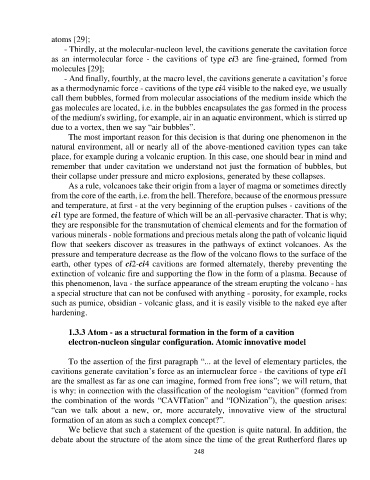Page 249 - Теория кавитации
P. 249
atoms [29];
- Thirdly, at the molecular-nucleon level, the cavitions generate the cavitation force
as an intermolecular force - the cavitions of type ci3 are fine-grained, formed from
molecules [29];
- And finally, fourthly, at the macro level, the cavitions generate a cavitation’s force
as a thermodynamic force - cavitions of the type ci4 visible to the naked eye, we usually
call them bubbles, formed from molecular associations of the medium inside which the
gas molecules are located, i.e. in the bubbles encapsulates the gas formed in the process
of the medium's swirling, for example, air in an aquatic environment, which is stirred up
due to a vortex, then we say “air bubbles”.
The most important reason for this decision is that during one phenomenon in the
natural environment, all or nearly all of the above-mentioned cavition types can take
place, for example during a volcanic eruption. In this case, one should bear in mind and
remember that under cavitation we understand not just the formation of bubbles, but
their collapse under pressure and micro explosions, generated by these collapses.
As a rule, volcanoes take their origin from a layer of magma or sometimes directly
from the core of the earth, i.e. from the hell. Therefore, because of the enormous pressure
and temperature, at first - at the very beginning of the eruption pulses - cavitions of the
ci1 type are formed, the feature of which will be an all-pervasive character. That is why;
they are responsible for the transmutation of chemical elements and for the formation of
various minerals - noble formations and precious metals along the path of volcanic liquid
flow that seekers discover as treasures in the pathways of extinct volcanoes. As the
pressure and temperature decrease as the flow of the volcano flows to the surface of the
earth, other types of ci2-ci4 cavitions are formed alternately, thereby preventing the
extinction of volcanic fire and supporting the flow in the form of a plasma. Because of
this phenomenon, lava - the surface appearance of the stream erupting the volcano - has
a special structure that can not be confused with anything - porosity, for example, rocks
such as pumice, obsidian - volcanic glass, and it is easily visible to the naked eye after
hardening.
1.3.3 Atom - as a structural formation in the form of a cavition
electron-nucleon singular configuration. Atomic innovative model
To the assertion of the first paragraph “... at the level of elementary particles, the
cavitions generate cavitation’s force as an internuclear force - the cavitions of type ci1
are the smallest as far as one can imagine, formed from free ions”; we will return, that
is why: in connection with the classification of the neologism “cavition” (formed from
the combination of the words “CAVITation” and “IONization”), the question arises:
“can we talk about a new, or, more accurately, innovative view of the structural
formation of an atom as such a complex concept?”.
We believe that such a statement of the question is quite natural. In addition, the
debate about the structure of the atom since the time of the great Rutherford flares up
248

